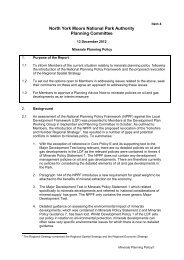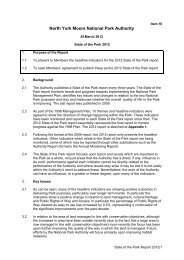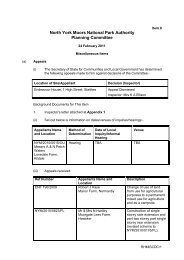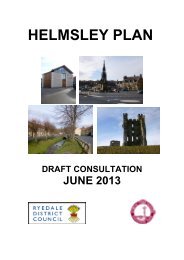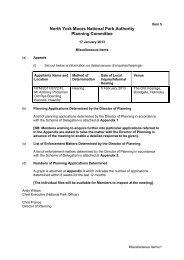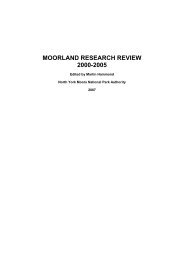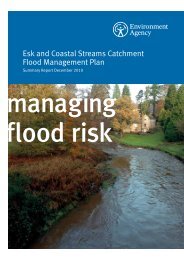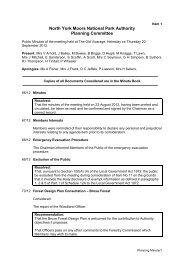Management Plan - North York Moors National Park
Management Plan - North York Moors National Park
Management Plan - North York Moors National Park
You also want an ePaper? Increase the reach of your titles
YUMPU automatically turns print PDFs into web optimized ePapers that Google loves.
Most of the <strong>National</strong> <strong>Park</strong> is generally considered to benatural, remote, wild and free from human impact, with themost tranquil areas of the <strong>National</strong> <strong>Park</strong> being the moorlandand dales. Other elements of the <strong>National</strong> <strong>Park</strong> thatcontribute towards its sense of tranquillity include runningwater and, particularly in the south of the <strong>National</strong> <strong>Park</strong>, thepresence of native trees and woodland. With the exceptionof some small pockets close to built up areas on the fringesof the <strong>National</strong> <strong>Park</strong>, the ability to see stars at night featureshighly across the area.The less tranquil areas of the <strong>National</strong> <strong>Park</strong> are broadlycorrelated to the road network and the fringes which areclose to urban areas. Most of the <strong>National</strong> <strong>Park</strong> would appearto suffer from at least occasional noise from roads. Noisefrom motorcycles and aircraft including helicopters can alsodetract from tranquillity. In the Esk Valley, central areas, thecoast, fringes and roads of the <strong>National</strong> <strong>Park</strong>, tranquillity isreduced due to the concentration of people.The tranquillity of the <strong>National</strong> <strong>Park</strong> is also known to beaffected by the use of off-road motorised vehicles forrecreational purposes. In addition to noise, the accumulationof non-natural items can also impact upon the perceptionof tranquillity, such as signs, tracks and structures associatedwith recreational shooting and large structures such as windturbines.Dark night skies mapping produced by CPRE shows thatthe area of skies classed as ‘dark’ declined between 1993and 2000. It is unknown to what extent this trend hascontinued. Dark skies are diminished by road and streetlighting, domestic security lighting, sports grounds, mastlights and other large premises particularly where they arelocated in open countryside. In the case of the <strong>North</strong> <strong>York</strong><strong>Moors</strong> intrusion of light into the dark night skies is thoughtto be generally a result of its proximity to large urban areas,particularly Teesside to the north. The Authority has workedwith the Ministry of Defence over training proposals andissues such as security lighting at Fylingdales which hasresulted in significant improvements. Generally though the<strong>National</strong> <strong>Park</strong>’s night skies are considered to be dark andSutton Bank Visitor Centre has recently been identified as aDark Sky Discovery Centre.Challenges● The potential for increases in levels of light pollution,noise and disturbance from both within and beyond the<strong>National</strong> <strong>Park</strong>.● Increasing levels of traffic.● Managing the potential increase in the number of visitors.● Pressure for large scale developments, particularly windfarms, outside but close to the <strong>National</strong> <strong>Park</strong>.In 15 Years Time…Most of the <strong>National</strong> <strong>Park</strong> is considered to be a tranquil place.Increases in visitor numbers and new development do notundermine the tranquillity of the <strong>National</strong> <strong>Park</strong>.<strong>North</strong> <strong>York</strong> <strong>Moors</strong> <strong>National</strong> <strong>Park</strong> <strong>Management</strong> <strong>Plan</strong>39




